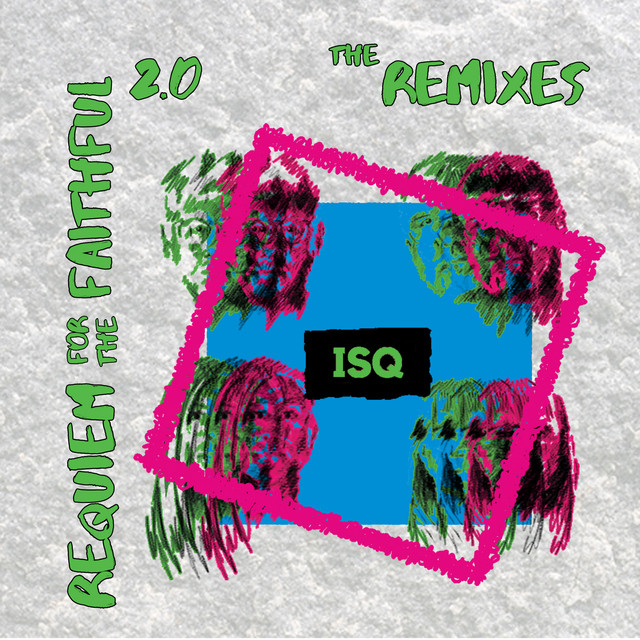The Breakdown
There’s something to be said about the mere act of dancing, post-covid. Let’s just start with that. Whether you’re into club culture or not, we’ve all had a burning desire to dance, with other people. That free flow ecstatic waltz into movement, that enables us to feel human again.
Enter ISQ. A powerhouse of a quartet, known for their subtle electronic-vocal-alt jazz led by vocalist Irene Serra. They’ve not only provided the soundtrack to the summer we didn’t know we needed, they’ve managed to elevate dance music up an infinite amount of notches, simply because, well, it’s now a thing: Jazz is officially cool again. For the non- jazz affiliates, you will end up appreciating jazz because of this album. For the jazzers- it will inspire you to re-think your own compositions. ISQ have managed with this remix album, Requiem for The Faithful 2.0 to provide a whole new album , expanding their sonic tapestry to defy what a vocal led quartet should sound like. It’s a brilliant move, and should be noted that all it was recorded entirely by ISQ, featuring stellar musicians Naadia Sheriff (piano), Richard Sadler (double bass), and Chris Nickolls (drums), in collaboration with some of the biggest names in the electronic industry. It’s mind blowingly beautiful when you think of how a alt-jazz quartet decided to challenge their creative prowess by completely opening up their original work to new horizons. So, in fact, the album is not really a collection of remixes- they are in fact, new songs.
The album features stellar re-creations from the likes of Arthur Baker, Faithless’ former lead guitarist Slovo, Emmanuelle, and BAFTA nominated Vince Pope. I’ve listened of course to the original album from ISQ, version 1.0 if you will, and have to wonder if people who aren’t familiar with this truly unique quartet will benefit from appreciating the magnitude of the re-creations of their original work without listening to the two versions of the albums.
All tracks on this album are virtually unrecognizable from the first. In fact, Serra’s soaring vocals sound like a completely different artist in version 2.0, which is a good thing, because it shows the calibre of the collaborators and the fluid musicianship of the band, all masters of their craft, creating a perfect harmonic platform for Serra to use as her sonic playground. Starting off with the first track, ‘We All Bleed’, Wolf & I sample only some of Serra’s lyrics, using her soft timbres to flow in and out of the synth charged harmonics in what otherwise would be classified as an IBIZA Summer 2010 Lounge Track . That’s really what stood out the most for me, because throughout the album each collaborator brought their own vibe, their own preferences of their own accord to re-shape an already great track. ‘Ode to Myself’ is another obvious example, with Arthur Baker majestically making full use of a more jazzy sounding Serra- non-jazzers, take note: most of the vocals you admire in house tracks are performed by high quality jazz singers. The improvising quality of Serra’s voice is quite soothing in sound, and in particular she is expertly supported by pianist Naadia Sheriff, who displays an uncanny ability to dip in and out of each track with such ease it would make anyone weep with joy. “In my Bed” and “Stone” are masterful crafts showcasing drummer Nickolls and Sadler’s simple yet eloquent bass lines – another sound is created in these two tracks: as if Groove Armada walked in and had a live jam with ISQ on a rooftop in Marrakech. I say that, with such specificity because that’s how brilliant the songs are on their own, painting visual images associated with the films we associate with dance culture, i.e. K.I.D.S, and ofcourse, It’s All Gone Pete Tong. ” Panic Room” , remixed by Bruce James is the most recognisable of the original album, beautifully giving an extra ambient sound and depth to the soulful pop-esque sounding Serra and co. “Orbit “, mixed by band member ‘Sadler’ is truly another highlight of the album, showcasing the band’s own ability to exercise their own influences. Sadler is brilliant and shining the spotlight of Sheriff’s soaring hammond organ and Sadler’s emotionally haunting bass lines. Nickoll’s displays a feel that I haven’t heard in a while – as a drummer he respects the softer nuances of Serra’s vocal range, yet provides a colourful palette for which the band can explore, especially giving the collaborators on this version the tools they need to use singular vs stereoscopic sound, especially in tracks “Paper Doll” (Remo The Hitmaker) and “Loving a Stranger” (Vince Pope),the latter more a harmonic, emotive re-work of the original. If anything, “Loving a Stranger” could be considered the ballad of the entire album. The penultimate track of the album, “Where Beauty Lives ” is a masterclass in re-writting. It’s a track , that if one hears the original, again, it’s unrecognizable. With Sheriff’s exquisite playing, a river of lyrical motion breathing new life into the track, it serves as the perfect prelude to the last track , the haunting “Lost Where We Belong”. Postmodern in sound, ISQ are clearly visual storytellers. It is clearly an ode to re-creating in a time where nothing makes sense, and sometimes we all take comfort in the unknown.
Dancers, jazzers, humans who need to move : get your copy of ISQ’s ‘Requiem for The Faithful 2.0’ here .














No Comment